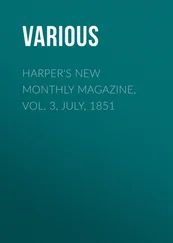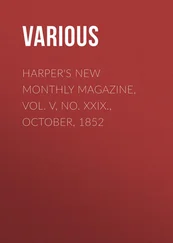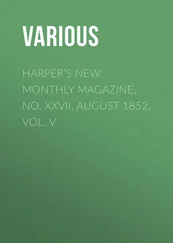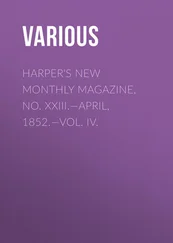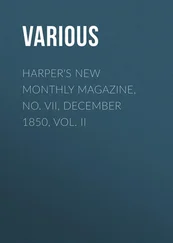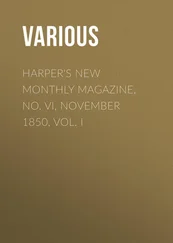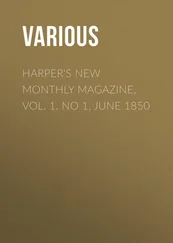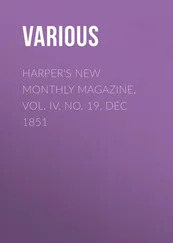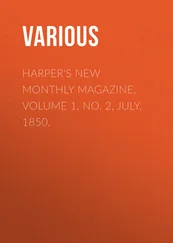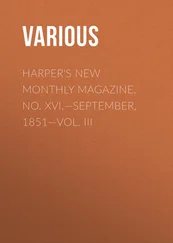Various - Harper's New Monthly Magazine, No. XXVI, July 1852, Vol. V
Здесь есть возможность читать онлайн «Various - Harper's New Monthly Magazine, No. XXVI, July 1852, Vol. V» — ознакомительный отрывок электронной книги совершенно бесплатно, а после прочтения отрывка купить полную версию. В некоторых случаях можно слушать аудио, скачать через торрент в формате fb2 и присутствует краткое содержание. Издательство: Иностранный паблик, Жанр: periodic, foreign_edu, на английском языке. Описание произведения, (предисловие) а так же отзывы посетителей доступны на портале библиотеки ЛибКат.
- Название:Harper's New Monthly Magazine, No. XXVI, July 1852, Vol. V
- Автор:
- Издательство:Иностранный паблик
- Жанр:
- Год:неизвестен
- ISBN:нет данных
- Рейтинг книги:4 / 5. Голосов: 1
-
Избранное:Добавить в избранное
- Отзывы:
-
Ваша оценка:
- 80
- 1
- 2
- 3
- 4
- 5
Harper's New Monthly Magazine, No. XXVI, July 1852, Vol. V: краткое содержание, описание и аннотация
Предлагаем к чтению аннотацию, описание, краткое содержание или предисловие (зависит от того, что написал сам автор книги «Harper's New Monthly Magazine, No. XXVI, July 1852, Vol. V»). Если вы не нашли необходимую информацию о книге — напишите в комментариях, мы постараемся отыскать её.
Harper's New Monthly Magazine, No. XXVI, July 1852, Vol. V — читать онлайн ознакомительный отрывок
Ниже представлен текст книги, разбитый по страницам. Система сохранения места последней прочитанной страницы, позволяет с удобством читать онлайн бесплатно книгу «Harper's New Monthly Magazine, No. XXVI, July 1852, Vol. V», без необходимости каждый раз заново искать на чём Вы остановились. Поставьте закладку, и сможете в любой момент перейти на страницу, на которой закончили чтение.
Интервал:
Закладка:
One of the most interesting and curious parts of the process of the manufacture of the barrel, is the straightening of it. We ought, perhaps, rather to say the straightenings, for it is found necessary that the operation should be several times performed. For example, the barrel must be straightened before it is turned, and then, inasmuch as in the process of turning it generally gets more or less sprung , it must be straightened again afterward. In fact, every important operation performed upon the barrel is likely to cause some deflection in it, which requires to be subsequently corrected, so that the process must be repeated several times. The actual work of straightening, that is the mechanical act that is performed, is very simple – consisting as it does of merely striking a blow. The whole difficulty lies in determining when and where the correction is required. In other words, the making straight is very easily and quickly done; the thing attended with difficulty is to find out when and where the work is crooked; for the deflections which it is thus required to remedy, are so extremely slight, that all ordinary modes of examination would fail wholly to detect them; while yet they are sufficiently great to disturb very essentially the range and direction of the ball which should issue from the barrel, affected by them.
The above engraving represents the workman in the act of examining the interior of a barrel with a view to ascertaining whether it be straight. On the floor, in the direction toward which the barrel is pointed, is a small mirror, in which the workman sees, through the tube, a reflection of a certain pane of glass in the window. The pane in question is marked by a diagonal line, which may be seen upon it, in the view, passing from one corner to the other. This diagonal line now is reflected by the mirror into the bore of the barrel, and then it is reflected again to the eye of the observer; for the surface of the iron on the inside of the barrel is left in a most brilliantly polished condition, by the boring and the operations connected therewith. Now the workman, in some mysterious way or other, detects the slightest deviation from straightness in the barrel, by the appearance which this reflection presents to his eye, as he looks through the bore in the manner represented in the drawing. He is always ready to explain very politely to his visitor exactly how this is done, and to allow the lady to look through the tube and see for herself. All that she is able to see, however, in such cases is a very resplendent congeries of concentric rings, forming a spectacle of very dazzling brilliancy, which pleases and delights her, though the mystery of the reflected line generally remains as profound a mystery after the observation as before. This is, in fact, the result which might have been expected, since it is generally found that all demonstrations and explanations relating to the science of optics and light, addressed to the uninitiated, end in plunging them into greater darkness than ever.
The only object which the mirror upon the floor serves, in the operation, is to save the workman from the fatigue of holding up the barrel, which it would be necessary for him to do at each observation, if he were to look at the window pane directly. By having a reflecting surface at the floor he can point the barrel downward, when he wishes to look through it, and this greatly facilitates the manipulation. There is a rest, too, provided for the barrel, to support it while the operator is looking through. He plants the end of the tube in this rest, with a peculiar grace and dexterity, and then, turning it round and round, in order to bring every part of the inner surface to the test of the reflection, he accomplishes the object of his scrutiny in a moment, and then recovering the barrel, he lays it across a sort of anvil which stands by his side, and strikes a gentle blow upon it wherever a correction was found to be required. Thus the operation, though it often seems a very difficult one for the visitor to understand, proves a very easy one for the workman to perform.
OLD MODE OF STRAIGHTENING
In former times a mode altogether different from this was adopted to test the interior rectitude of the barrel. A very slender line, formed of a hair or some similar substance, was passed through the barrel — dropped through, in fact, by means of a small weight attached to the end of it. This line was then drawn tight, and the workman looking through, turned the barrel round so as to bring the line into coincidence successively with every portion of the inner surface. If now there existed any concavity in any part of this surface, the line would show it by the distance which would there appear between the line itself and its reflection in the metal. The present method, however, which has now been in use about thirty years, is found to be far superior to the old one; so much so in fact that all the muskets manufactured before that period have since been condemned as unfit for use, on account mainly of the crookedness of the barrels. When we consider, however, that the calculation is that in ordinary engagements less than one out of every hundred of the balls that are discharged take effect; that is, that ninety-nine out of every hundred go wide of the mark for which they are intended, from causes that must be wholly independent of any want of accuracy in the aiming, it would seem to those who know little of such subjects, that to condemn muskets for deviating from perfect straightness by less than a hair, must be quite an unnecessary nicety. The truth is, however, that all concerned in the establishment at Springfield, seem to be animated by a common determination, that whatever may be the use that is ultimately to be made of their work, the instrument itself, as it comes from their hands, shall be absolutely perfect; and whoever looks at the result, as they now attain it, will admit that they carry out their determination in a very successful manner.
CINDER HOLES
Various other improvements have been made from time to time in the mode of manufacturing and finishing the musket, which have led to the condemnation or alteration of those made before the improvements were introduced. A striking illustration of this is afforded by the case of what are called cinder holes . A cinder hole is a small cavity left in the iron at the time of the manufacture of it – the effect, doubtless, of some small development of gas forming a bubble in the substance of the iron. If the bubble is near the inner surface of the barrel when it is welded, the process of boring and finishing brings it into view, in the form of a small blemish seen in the side of the bore. At a former period in the history of the Armory, defects of this kind were not considered essential, so long as they were so small as not to weaken the barrel. It was found, however, at length that such cavities, by retaining the moisture and other products of combustion resulting from the discharge of the piece, were subject to corrosion, and gradual enlargement, so as finally to weaken the barrel in a fatal manner. It was decided therefore that the existence of cinder holes in a barrel should thenceforth be a sufficient cause for its rejection, and all the muskets manufactured before that time have since been condemned and sold; the design of the department being to retain in the public arsenals only arms of the most perfect and unexceptionable character.
At the present time, in the process of manufacturing the barrels, it is not always found necessary to reject a barrel absolutely in every case where a cinder hole appears. Sometimes the iron may be forced in, by a blow upon the outside, sufficiently to enable the workman to bore the cinder hole out entirely. This course is always adopted where the thickness of the iron will allow it, and in such cases the barrel is saved. Where this can not be done, the part affected is sometimes cut off, and a short barrel is made, for an arm called a musketoon.
Читать дальшеИнтервал:
Закладка:
Похожие книги на «Harper's New Monthly Magazine, No. XXVI, July 1852, Vol. V»
Представляем Вашему вниманию похожие книги на «Harper's New Monthly Magazine, No. XXVI, July 1852, Vol. V» списком для выбора. Мы отобрали схожую по названию и смыслу литературу в надежде предоставить читателям больше вариантов отыскать новые, интересные, ещё непрочитанные произведения.
Обсуждение, отзывы о книге «Harper's New Monthly Magazine, No. XXVI, July 1852, Vol. V» и просто собственные мнения читателей. Оставьте ваши комментарии, напишите, что Вы думаете о произведении, его смысле или главных героях. Укажите что конкретно понравилось, а что нет, и почему Вы так считаете.

